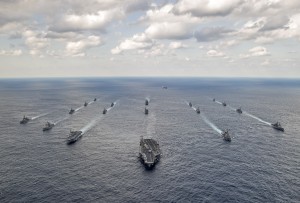 When confronted at sea, Americans have an unbroken, century-long record of building new maritime competitors–whomever they are–into ten feet tall, impossible-to-defeat monsters targeted directly at the good ‘ole U.S.A..
When confronted at sea, Americans have an unbroken, century-long record of building new maritime competitors–whomever they are–into ten feet tall, impossible-to-defeat monsters targeted directly at the good ‘ole U.S.A..
Maybe it’s some institutional holdover from America’s early underdog struggles against the British Fleet, but this habit of fearfully over-hyping anything and everything challenging in the maritime domain has got to stop.
I’ve said it many times over–the moment America’s competitors and American allies start to believe America’s fearful hype, we’re going to have real trouble. (For those just joining, I have made this point before, in discussions about China’s DF-21D “Carrier Killer” missile, here.)
So, before retiring to the fainting couch over the current anti-ship-cruise-missile “threat-of-the-moment”, just take a second and remember that America has the largest Navy on the planet, some great sailors and good amount of wonderful ships. Sure, the Navy ain’t perfect, but the U.S. Navy is, in the near-to-mid-term, yards beyond any contender out there.
Like the embarrassingly over-hyped DF-21D “Carrier Killer”, Chinese-fueled proliferation of anti-ship-cruise missiles (ASCMs) is a manageable problem.
Bryan Clark’s recently released CSBA study, “Commanding the Seas: A Plan to Reinvigorate U.S. Navy Surface Warfare“, makes a welcome step towards level-headed discussion about managing this particular hazard (I’ve been discussing the essay this week, here).
And yet, on the other side of the equation, journalists who read Mr. Clark’s study last week are now rushing to file Awesome (!) Chinese Cruise Missile (!) Tech (!) stories from the 10th China International Aviation and Aerospace Exhibition, which closed…what? Two weeks ago?
It’s not all hype-driven coverage though. Here’s a great must-read piece from Aviation Week’s Bill Sweetman:
Stealth fighters get the attention even though they smoke like Humphrey Bogart, but there is a lot of PLA money going into reconnaissance-strike complexes that can hold power-projection forces at risk from far beyond the horizon, and radars that are designed to detect, track and target stealth aircraft. That’s the rabbit, and we take our eyes off it at our peril.
I agree with Bill. We need to track and manage this problem, and I hope that solid media coverage like Bill’s will propel more rational discussion rather than spark reflexive “duck-and-cover” hype.
But the CSBA solution is not the way to do it. It was oversold. Billed as an offensive strategy, the CSBA plan is too defensive, too reactive, too America-focused and far too tactically minded to, ah, change the game.
The CSBA report is just a discussion of close-in-air-defense. That’s about it. Let me put it this way–In World War II, the mass festooning of 40mm and 20mm anti-aircraft guns over every battlewagon gave America’s battleships new relevance, but those AA weapons sure didn’t turn the tide of the war—and certainly no former officer would have dared to go before Admiral Ernest King and argue that the development of close-in air defense was an awesome, game-changing “offensive” development.
But I digress. We were talking about management. So…How, as I leaf through the CSBA report, I’m left to wonder just how the Japanese might be handling this anti-ship cruise missile hazard?
They’re at real risk, right?
Right?
Crickets.
Sigh.
If America is going to mull offensive measures to better meet the Chinese anti-ship-missile threat, then let’s talk about taking the @#$!%$ offensive–with our targeted friends in the region who are under the real threat.
The threat of massed salvos of anti-ship cruise missiles is a regional challenge, so, well, manage it that way!!
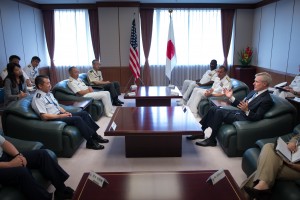 It’s About Building A Pacific NATO:
It’s About Building A Pacific NATO:
On a strategic level, anti-ship missile proliferation is a regional problem, and, in any future examination of the anti-ship missile threat, American policymakers must start there and end there.
China’s anti-ship missile threat is, first-and-foremost, a threat to our allies. The big navies of Japan, South Korea live under the Chinese missile umbrella every day. The smaller navies of Vietnam, the Philippines and Taiwan live under threat too. Do they recognize the hazard? If so, how are they responding? How can we help them sail in their national waters and nearby seas without fear?
Rather than freely broadcast an overly timorous U.S.-centric view of the threat, defense thinkers might consider portraying the proliferation of Chinese Anti-Ship missiles as a regional hazard, aimed, first-and-foremost, at America’s good friends.
Then, if we’re convinced, as Bryan Clark is, that owning the offensive side of the equation is more economical (which deserves a little more analysis than statements of defense/offense tradeoffs usually get–I mean, that $1-3 million dollar ASCM doesn’t fire–and hit–without a costly support infrastructure), then, well, rather than floating something defensive like Aegis ashore–which Bryan Clark does–let’s start talking about providing our less tech-savvy partners some simple, low-cost offensive options.
You know–why not proffer something basic–like anti-ship missiles on a truck or in a CONEX box? Nobody’s even broaching that idea.
If China’s “ISR and Strike” complex is the threat, then let’s try empowering our allies with simple, small-warhead, long-range anti-ship weapons. That would put a real squeeze on all those low-end quasi-military (and likely ISR-supporting) surface assets favored by one of America’s Peer Competitors…oh, I mean, Asia’s aspirant Hegemon. Such a move would exploit China’s enduring weakness in SAM defenses (which, at sea, appears to be predominantly built on close-in AAW).
So, rather than suggest we spend a ton of Navy money to deploy defense-minded Aegis Ashore batteries in Japan (which, mind you, would be useful BUT SHOULD BE A JAPANESE-GENERATED PROPOSAL, NOT AN AMERICAN ONE, ahem), or fitting a wave-riding hypersonic do-hickey atop an SM-3 (which we would then promptly waste by firing at some threatening-looking yet dirt-cheap Houbei Class Fast Attack Catamaran or errant and emitting fishing junk), I’d suggest that we (the U.S., Australia, Japan…along with France, Singapore or South Korea) work to crash-develop our own dirt-cheap modular anti-ship cruise missile that is capable of being deployed in real numbers–and operated by “beginners”.
A simple AK-47 for the maritime set would do a lot to complicate China’s regional targeting solutions.
If we are actually serious about challenging potential regional hegemonic threats, and actually serious about going on offense, then what better way to complicate our competitor’s targeting problems by introducing a cheap, simple anti-ship missile for Over-the-Horizon use by the Vietnamese and Philippines…in, say, their coastal waters?
Or the South China Seas?
Or the Taiwan Straits?
I’m not suggesting anything fancy that couldn’t be relatively easily defeated by front-line systems, but just something that would make the average skipper of a Chinese quasi-military maritime militia boat sweat a bit. Something that would strike a little fear in that big cheap armada of Chinese lawfare and low-cost ISR assets that…all lack organic self-defense capabilities.
Once the region has a means of offering the Chinese a taste of their own anti-ship medicine–starting, possibly, with a bare-bones, simple, lowest-common-denominator anti-ship missile (as a notional price-point-per-round, I’d suggest something that costs less than one of China’s average maritime security platforms), the behavioral standards in the region’s contested areas might change a bit.
But I can hear the concerned hand-wringing already. Look, all I’m talking about is a rocket-engine, a bit of explosive and some really simple, bare-bones (but easily and quietly upgradable!) seeker/sensors. That’s all we need to make the Chinese start to worry about just what they might be putting into their VLS tubes. Needless to say, every missile China devotes to anti-missile defenses (or to silencing a battery of low-end anti-ship missiles) is one less anti-ship/surface-to-surface missile the MPF–or Multinational Pacific Fleet–needs to worry about.
Save the laser-infused, hypersonic gold-plating for some quiet dark program someplace.
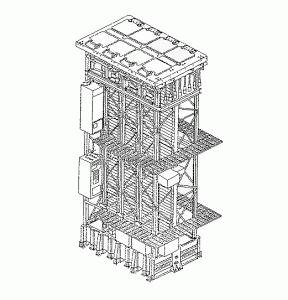 Realize that Any Competitor’s Missiles are Limited:
Realize that Any Competitor’s Missiles are Limited:
For all Mr. Clark’s hand-wringing about the limited capacity of the U.S. Navy’s VLS cells (of which I have, yes, been a part of since, oh, 2010, here, here and here), the region also needs to understand that the near-to-mid term threat to big, protected and conservatively-operated targets seems relatively surmountable. Bryan says it here:
Today’s long-range ASCMs cost from $1 million–$3 million whereas an ASBM costs about $6 million–$10 million; an adversary could be expected to launch dozens of them in each attempt to disable or destroy a $1 billion–$2 billion DDG or the $11 billion carrier it defends.
So by 2025, Bryan expects an adversary to use dozens of effectors to kill a carrier.
Dozens.
Let that sink in for a minute. Yes, that’s a lot, but not an enormous lot.
It comes down to logistics. How many missiles can China realistically maneuver into launch positions?
In comparison to some of the apocalyptic rhetoric spouted by the usual alarmists, the idea of a few dozen missiles in a salvo seems relatively manageable given the current state of the fleet. For a fleet that has some 10,000 VLS cells in their inventory (and a lot more if we include allied inventories), a salvo of dozens of…things…is something we should be able to withstand without taking extraordinary measures–or, for that matter, changing up our current air-defense scheme too much.
(As an aside, go take a look at the top photo for this post. It’s a released Navy image of the Japanese and U.S. Navy fleets cruising in mid November–A CVN, two helo carriers, a couple of cruisers, a brace of Burkes, and a host of other VLS-equipped Japanese surface warships. How many VLS cells are there, in that fleet alone?)
So…the near-to-mid-term threat is dozens. Not hundreds. Dozens. Of…things.
This, of course, won’t sit well with the A2/AD “sky-is-falling” set. They all sorta have this idea that all the missiles in all the world are going to be targeted at the Fleet all at once from all angles. That’s not gonna happen. The 1000 Short Range Ballistic Missiles of the Chinese Second Artillery Force will not be expended all in one go, and the majority of them will be focused on that particularly tricky area of the Chinese coastline near Taiwan. A Kilo Class Sub’s missile magazine isn’t bottomless. And only so many Chinese-flagged cargo ships can carry containerized pop-up ASCMs without attracting…notice.
It comes down to logistics.
Any adversary–even our most dedicated and most sneaky–would be hard-pressed in the near-to-mid-term to marshal all the ships, aircraft and other effectors needed for a truly massive cruise missile salvo without taking some obvious, detectable–and easily halted–steps.
And as for the second salvo? Getting in place for a second salvo would, I expect, be hard to do against a fully-alerted fleet–and, I also fully expect that, by the time some Cold War-like competitor massed up for a second salvo (everybody takes the “second salvo” for granted, but nobody tells us lowly open-sector folk when we might expect one–in 30 minutes? Six hours? Two days?), that adversary would be….well, dealing with challenges that range from nuclear detonations (and yes, however barbaric and horrid it is, America should talk more openly about nuclear deterrence in response to conventional first-strikes) to country-wide power disruptions, wholesale comms shutouts or stealthy conventional “Prompt Global Strike” strikes.
The anti-ship missile threat outside a few “near” seas remains somewhat inflated–and over the near-to-mid-term the threat is more manageable than portrayed.
Put the hype aside and think.
Hype is just an lazy way to encourage Congress to part with taxpayer money. Remember all those those guys who spent the last few years hyping the mythical and invulnerable A2/D2 unicorn called the “Iranian small boat swarm”? A small-boat swarm sounds fearful in aggregate, but when broken into small pieces, the problem becomes quite manageable (some old stuff here, here and here). That small boat swarm isn’t gonna pop up out of nowhere…it has to gather and get logistical support from someplace. And the small boat fleet has to sally forth from somewhere.
So, to defeat these hyped-up A2/AD threats, the Navy must focus a bit more on the basics–readiness, intel collection and intel dissemination, deception and training–before rushing off to adopt an entirely new set of tech n’ tactics.
Curling the fleet into a concentrated defensive crouch over the threat of a few dozen effectors isn’t the way to go–at least in a strategic sense. In any discussion of China’s effort to control their region–be it with cruise missiles, ballistic missiles, or other things–we need to start with a regional approach and end with a regional approach.
If our allies can sail in their seas without fear, the good guys win. That’s the goal.
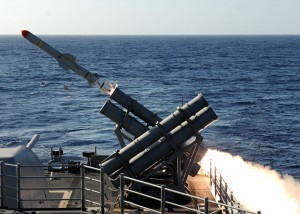
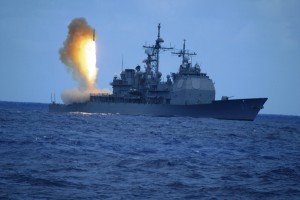

{ 15 comments }
I think calling it hype may be a bit much… Sometime just having another model is a good way to start a conversation. Clark’s paper got you to put down some pretty reasonable counter-arguments. It also made me think a lot about the logical half-life of a US destroyer in the South China Sea during a conventional war. Ugh…
The scary possibility is that for a single DDG, the Chinese can afford 100 ASBMs. For a carrier, that number rises up to 1000, so provided that the Chinese find an efficient way to store and transport them, ASBMs can saturate almost any missile defense.
A 737 size aircraft can carry 35 cruise missiles in rotary launchers. So four basic commercial type aircraft can launch a mix of 140 cruise missiles at a fleet from 500-1000nm with little risk. Best to launch in two teams, firing at the target area from right angles. The missiles will be of all types. Details here: http://www.g2mil.com/bm747.htm If we are lucky 90% miss or get shot down, so only 14 hit ships, and half the fleet survives as the four aircraft return the next day.
Then just for fun, send some subs and ballistic missiles at the same time.
500nm and “little risk” no way, even at 1k nm you aren’t going to go unnoticed or ignored (especially if you can only run at ~500 knots). You also don’t address targetting, perhaps in a surprise attack you can get a local fix and release, but only once. Then, even in your obviously worst case scenario, you have 140 inbounds, a typical CGB (without reenfocements or AAW specialized VLS loadout) has somewhere around 250 SM-2/6 followed by ESSM and CiWS (or LaWS/EMRG in future conflicts) plus ECM so a 10% leak rate is probably very high, I’ve seen estimates that give ASCM about the same success rate as a WWII Kamikaze, which was about 2-3%, so your looking at a 3-4 hits if you can get those 140 missiles off, that would be bad for the CBG, but does that look like a good gamble from the strike perspective, knowing the relatiation from the CBG or other allied forces will be swift and devastating.
If you had bothered to read that link your questions would have been answered. For example, the cruise missile bombers would be escorted by AWACS type aircraft with far more radar range than F-35s. And of course a CBG can’t fire all its missiles in the span of a few minutes, with most systems shooting each other down.
And let me add that $140 million for 140 missiles is not that much to take on a $30 billion CBG, just the cost of an F-35. After the CBG has shot off all it has, expect another flight of four aircraft launching another 140 missiles an hour later. And the next day, and next….
Well if the CGB is so easily tracked and engaged without any means to shoot your archers, then yes the CBG is in trouble, but at 1k nm, even with an AWACS you can’t fix the CBG. What’s the tracking cone of a ASCM? Not nearly big enough to go searching around for surface targets (especially if they’re being jammed or decoyed). Plus, even at 1k nm you aren’t outside the reach of the fighters. It’s one thing to dash in with something like a flight of Soviet Backfire bombers, quite another with an airliner.
Invoking non-lethal lasers & non-credible rail guns detracts from your argument.
Since adversaries have the same common technical issues as we do –
What about the development and test program for the rotary missile launcher install / integration and assorted GNC and tracking issues to support a weapon? I don’t get to wave a magic wand and ‘poof’ a system leaps of a deck of powerpoint slides. How about without a robust T&E program less than 20% of the time you have a suitable targeting solution/handover and some small fraction of the missiles launch?
With current fleet defense; the outer ring clips some fraction of the inbounds and the inner ring addresses some fraction of the remainder. Since this is now a full up war the adversary has to anticipate the US scaling Dr. Kahn’s ladder as we will be really angry.
As to the 21d ASBM, fainting couches aren’t the issue; its a serious piece of work and it deserves respect and serious engineering responses. We should doubt the efficacy of the CEC / Aegis / SPY / AMDR path and tools if facing the 21d and its relatives in combat. The key issue is those are ‘semi-ballistic’ missiles that maneuver at times that offense chooses for targeting purposes. The current systems are adaptations / growth from air-defense tools and that ‘ballistic’ aspect of other missiles assists the application of such air-defense tools to BMD.
What’s the solution set for it?
I get to specify / re-architect fleet defense? Ok; repurpose and reequip the MQ-4s for Fleet surveillance support with appropriate IR sensors that are capable of precision tracking/FC against the ASBM RVs. (flying above cirrus clouds is key) Retask the F35c /b to feed its AN/AAQ-37 DAS data to CEC as it will see ASBMs while thrusting. (SAM warning sensor capabilities scale to longer ranges with brighter sources such as SSMs) On the RF side; walk away from monostatic microwave systems and work modern networked multistatic sensors with modern waveforms.
When tracking is robust; enforceable engagement opportunities exist even with SM-3 current versions.
A couple of comments –
SAMs and ASCMs should be cheaper than dirt ours included; your smart phone in your pocket has better communications, smarter processor and a better sensor than the current generation naval SAM.
The SCS could trivially be wrapped up by allied surveillance; the Aussies are the worlds experts in HF radar and HFSWR and OTHR Skywave / SkyLOS could cover the whole place 24/7/365 inexpensively operating with sites in Vietnam, Taiwan, Japan, the Philippines, Indonesia, Borneo and other places. Modern waveforms are hard to jam and the radars would have data products that support safety of navigation, search / rescue and a host of other needs. With other parties continuously watching; Chinese violations of UNLOS will be transparent. Airborne response to warn-off or attack (if needed) incursions is rapid with high quality surveillance support.
As to off-loading the BMD mission set; parking a couple of barges with VLS tubes and a version of the Desert Ship C2 instead of tethering a multiple billion multiple mission ship to some geographic spot for some low probability missile attack is military genius. (BMD does not deter offensive missiles, its a flawed economic choice to wait for the shot by ‘wooden round’ threats).
Aside from the fact that aviation resources are somewhat limited in that neck of the woods, who is going to dare challenge China by air once they have their nifty terraformed SCS airstrips in service?
Totally agree with you about the barges. Arsenal ships are overdue. Give me an oil tanker with extra power and some distributed launch cells/C2, fill the tanks with water, and it’ll do fine.
Craig,
I like where you’re going with this.
I proposed a somewhat more ambitious missile here (http://warships1discussionboards.yuku.com/topic/27656/Long-ranged-antiair-warfare#.VH8AtdWuxEg). Basically, use a scaled up MALI/MALD/LCI-like, turbojet-powered missile that can fit, quad-packed in a VLS cell.
I threw it out as a combined AAW, ASuW and strike weapon. The biggest complaint made by commenters was its lack of value as an AAW weapon. I accept some of the points, but still think it deserves further exploration.
I initially suggested using components from the Block II ESSM including warhead and active radar seeker, but using a passive IR (or IRST) seeker may be preferable.
There are a number of warheads that could be used, of varying size, including the aforementioned ESSM warhead (86lbs), the HARM warhead (146lbs), or one of the GMLRS warheads (~200lbs). All fit in a 9-inch diameter missile body. If this missile dispenses with the AAW mission, then the GMLRS warheads appear preferable.
Even the lowly ESSM warhead, if delayed-fuzed, should provide a decent capability against small combatants. The slightly smaller Sea Skua has done well with a similarly-sized warhead.
You’ll be hard pressed to get a rocket-powered missile to fly out far enough, so using an air-breathing engine is a must.
The resulting missile would be a step down from NSM/JSM in size, but with greater range.
A Philippine-base missile with a 500nm range, could cover most of the South China Sea. Missiles placed on islands in the Luzon Strait or the Yaeyama islands could hit targets in the Taiwan Strait (or even parts of the Chinese mainland). You’d just have to figure out the tricky problem of targeting.
Owing to its small size, this missile wouldn’t be classified as a Category I munition under the MTCR, so export would be easier.
Neat stuff; I was poking about in the archives of your original board post. Some nice discussions back there.
My sense is that sometimes the lowest-common-denominator solution actually is the right thing. But I sure wish somebody did some wargaming on really low-cost, simple solutions…
Comments on this entry are closed.